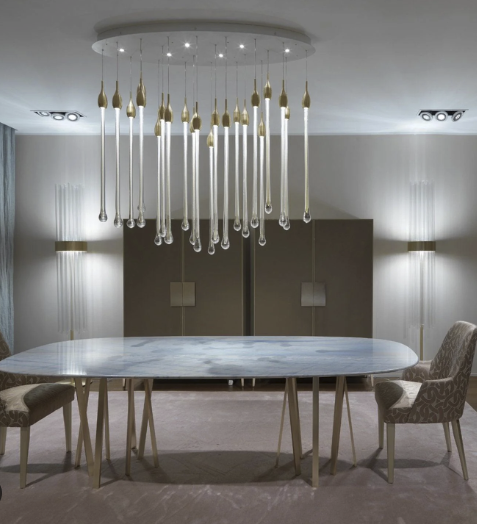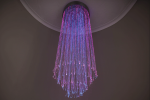The history of glass chandeliers is a fascinating journey that intertwines art, technology, and culture. Originating in the medieval period, chandeliers were initially crafted from wood and adorned with candles, serving as both a source of light and a symbol of wealth and status. As glassmaking techniques advanced, particularly during the Renaissance, artisans began to incorporate glass into their designs.
This shift marked a significant evolution in chandelier design, as glass not only enhanced the aesthetic appeal but also allowed for more intricate and delicate forms. The Venetian glassmakers of Murano became particularly renowned for their exquisite glass chandeliers, which featured elaborate designs and vibrant colors. These chandeliers Rocalamp were often commissioned by nobility and wealthy merchants, solidifying their status as luxury items.
By the 18th century, the popularity of glass chandeliers had spread across Europe, with various regions developing their unique styles. In France, for instance, the Baroque period saw the emergence of grandiose chandeliers that were often embellished with crystals and intricate metalwork. The use of lead crystal became prevalent during this time, as it refracted light beautifully, creating a dazzling effect that captivated onlookers.
The Industrial Revolution further propelled the production of glass chandeliers, making them more accessible to the burgeoning middle class. As a result, these stunning light fixtures began to adorn not only palaces and grand halls but also homes of varying sizes and styles, marking a significant democratization of luxury.
The Artistry and Craftsmanship Behind Glass Chandeliers
The Design Phase: Where Artistry Meets Functionality
Creating a glass chandelier is an intricate process that requires a high level of artistry and craftsmanship. Skilled artisans begin by designing the chandelier, often drawing inspiration from historical styles or natural forms. The design phase is crucial, as it dictates the overall aesthetic and functionality of the piece.
Material Selection: A Crucial Part of the Craftsmanship
Once the design is finalized, artisans select the appropriate materials, which may include various types of glass, metal components, and decorative elements such as crystals or beads. Each material contributes to the chandelier’s overall look and feel, making the selection process an essential part of the craftsmanship.
Construction and Assembly: A Delicate Balance of Art and Technique
The actual construction of a glass chandelier involves several meticulous steps. Artisans must blow or mold the glass into the desired shapes, which can range from simple globes to elaborate floral designs. This process requires not only technical skill but also an artistic eye to ensure that each piece harmonizes with the overall design. After the glass components are shaped, they are often polished and assembled with metal frames that provide structural support.
The Final Touches: Adding Brilliance and Captivating Beauty
The final touches may include adding crystals or other decorative elements that enhance the chandelier’s brilliance when illuminated. This combination of artistry and craftsmanship results in a stunning piece that serves as both a functional light source and a captivating work of art.
The Versatility of Glass Chandeliers in Home Decor
Glass chandeliers are remarkably versatile fixtures that can enhance a wide range of interior design styles. From traditional to contemporary spaces, these elegant light sources can be adapted to suit various aesthetics. In classic settings, ornate glass chandeliers with intricate detailing can serve as focal points in dining rooms or entryways, exuding an air of sophistication and grandeur.
Conversely, minimalist designs featuring clean lines and simple shapes can seamlessly integrate into modern interiors, providing a touch of elegance without overwhelming the space. This adaptability makes glass chandeliers an excellent choice for homeowners looking to elevate their decor. Moreover, glass chandeliers can be customized to fit specific design themes or color palettes.
Artisans can create bespoke pieces that reflect individual tastes and preferences, allowing homeowners to express their unique style through lighting. For instance, a coastal-themed home might feature a chandelier made from frosted glass in soft blues and whites, reminiscent of ocean waves. Alternatively, an industrial loft could benefit from a chandelier with exposed bulbs and raw metal accents, adding an edgy contrast to the sleekness of glass.
This ability to tailor chandeliers to specific environments ensures that they remain relevant and appealing across various design trends.
How to Choose the Perfect Glass Chandelier for Your Space
Selecting the perfect glass chandelier for your space involves careful consideration of several factors to ensure it complements your existing decor while fulfilling its functional role. First and foremost, it is essential to assess the size of the room where the chandelier will be installed. A large chandelier can serve as a stunning centerpiece in expansive areas such as grand dining rooms or entryways, while smaller spaces may benefit from more modest designs that do not overwhelm the surroundings.
Additionally, considering the height of the ceiling is crucial; chandeliers should be hung at an appropriate height to allow for comfortable movement beneath them while maximizing their visual impact. Another important aspect to consider is the style and finish of the chandelier. Homeowners should take into account their overall design theme—whether it leans towards traditional elegance or modern minimalism—and choose a chandelier that aligns with this vision.
The finish of the metal components can also play a significant role in achieving harmony within the space; for example, a brass finish may evoke a vintage charm, while polished chrome can lend a contemporary flair. Furthermore, considering the type of light bulbs used in the chandelier can affect both ambiance and energy efficiency; LED bulbs offer longevity and lower energy consumption while providing ample illumination.
Maintaining and Caring for Glass Chandeliers
Maintaining and caring for glass chandeliers is essential to preserve their beauty and functionality over time. Regular cleaning is crucial, as dust and grime can accumulate on both the glass surfaces and metal components, diminishing their brilliance. To clean a glass chandelier effectively, it is advisable to turn off the power supply and allow it to cool down before beginning any maintenance work.
Using a soft cloth or feather duster can help remove dust without scratching delicate surfaces. For more thorough cleaning, a mixture of warm water and mild soap can be used; however, it is important to avoid harsh chemicals that could damage the finish or etch the glass. In addition to regular cleaning, periodic inspections are necessary to ensure that all components are functioning correctly.
Homeowners should check for loose connections or damaged parts that may require repair or replacement. If any bulbs are burned out, they should be replaced promptly to maintain optimal lighting levels. For larger or more intricate chandeliers, it may be beneficial to hire professional cleaning services that specialize in delicate fixtures; they possess the expertise and tools needed to handle complex designs safely.
By investing time in maintenance and care, homeowners can enjoy their glass chandeliers for many years while keeping them looking as stunning as the day they were installed.
The Timeless Appeal of Glass Chandeliers in Modern Design
Timeless Elegance in Modern Design
Glass chandeliers have maintained their timeless appeal in modern design contexts, despite evolving design trends and changing tastes in home decor. Their ability to blend seamlessly with various styles, from classic elegance to contemporary minimalism, ensures that they remain relevant in today’s interiors. Modern designers often incorporate glass chandeliers into their projects not only for their aesthetic qualities but also for their capacity to create ambiance through light diffusion.
The Refractive Properties of Glass
The refractive properties of glass allow these fixtures to cast beautiful patterns across walls and ceilings when illuminated, adding depth and character to any space. This unique ability to diffuse light creates a captivating ambiance that enhances the overall aesthetic of a room.
Advancements in Technology and Sustainability
Advancements in technology have further enhanced the versatility of glass chandeliers in modern design. Contemporary lighting solutions often incorporate energy-efficient LED bulbs that provide bright illumination while consuming less power than traditional incandescent options. This shift towards sustainability aligns with current design philosophies that prioritize eco-friendly choices without compromising on style or elegance.
The Enduring Charm of Glass Chandeliers
As designers continue to explore innovative ways to integrate glass chandeliers into modern interiors, such as pairing them with smart home technology, their enduring charm remains an integral part of contemporary decor. The combination of timeless elegance, advanced technology, and sustainable design ensures that glass chandeliers will remain a popular choice for modern interior design.
The Symbolism and Significance of Glass Chandeliers
Glass chandeliers carry rich symbolism and significance that extend beyond their functional role as light sources. Historically associated with wealth and opulence, these fixtures have long been seen as status symbols within society. Their presence in grand halls and luxurious homes signifies not only affluence but also an appreciation for artistry and craftsmanship.
In many cultures, chandeliers are viewed as representations of enlightenment; their ability to illuminate spaces serves as a metaphor for knowledge and clarity. This duality—of being both decorative objects and symbols of deeper meanings—adds layers of significance to these stunning pieces. In addition to their historical connotations, glass chandeliers also evoke feelings of warmth and hospitality within modern homes.
When strategically placed in dining areas or living rooms, they create inviting atmospheres conducive to gatherings and celebrations. The soft glow emitted by these fixtures fosters connections among family members and friends alike, enhancing shared experiences around meals or special occasions. As such, glass chandeliers transcend mere decoration; they embody values of togetherness and community while enriching the emotional landscape of any space they inhabit.
The Future of Glass Chandeliers in Interior Design Trends
As we look toward the future of interior design trends, glass chandeliers are poised to remain prominent fixtures within residential spaces. With an increasing emphasis on personalization in home decor, bespoke chandeliers tailored to individual tastes are likely to gain popularity among homeowners seeking unique expressions of style. Artisans will continue to push boundaries by experimenting with innovative designs that incorporate mixed materials—such as combining glass with wood or metal—to create striking contrasts that resonate with contemporary sensibilities.
Furthermore, sustainability will play a crucial role in shaping the future of glass chandeliers as consumers become more conscious of their environmental impact. Designers may increasingly focus on using eco-friendly materials and energy-efficient lighting solutions while maintaining aesthetic appeal. This commitment to sustainability will not only cater to evolving consumer preferences but also ensure that glass chandeliers remain relevant in an ever-changing design landscape.
Ultimately, as trends evolve and new technologies emerge, glass chandeliers will continue to captivate audiences with their beauty, versatility, and enduring charm in interior design.


